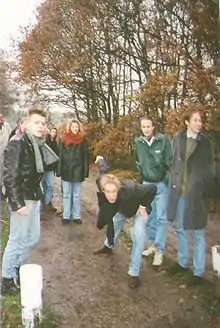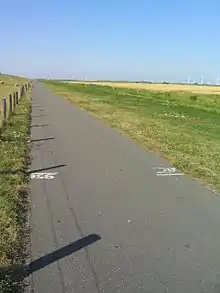Klootschieten
"Klootschieten" (NL)[1] ("Bosseln" or "Boßeln" in German; "Ball shooting" in English) is a sport in the Netherlands and East Frisia, Northern Germany, most popular in the eastern regions of Twente and Achterhoek. The game is of Frisian origin.[2] To play, participants throw a ball (the kloot) as far as they can, using a relatively difficult throwing style that requires speed, power, and concentration. The sport was banned at times, but achieved a measure of respectability when its first league was established by Hinrich Dunkhase in 1902.[3] The sport is divided into field, street, and standing play. Field and street play typically has two teams playing against each other, while standing play is individual. Stefan Albarus is the current record holder, throwing the ball 106.20 meters.[4]


History
The term Kloot comes from Low German and derives from Kluten, of similar etymology to English words such as "clod", "clout", "clot", "cleat", "clay" and "cloth" – all ultimately deriving from Proto-Germanic klautaz, meaning a ball or lump.
Klootschieten likely arose from an ancient Frisian weapon, which the Frisians threw at ships and opponents.[5] The Frisian fighters are said to have been feared for their missiles. In further development of this sport, heavy flint balls and two-pound iron balls were used. Later, the fist-sized balls were made of turned Applewood, pierced crosswise with lead-filled holes.
The Dutch reformer Jacobus van Oudenhoven took in 1659 the Kloot werpen on a Sunday after the service in his sins register.[6]
Kloot shooting, in the past, was viewed negatively by some. Competitions often involved gambling, heavy alcohol consumption, and disorderly conduct. Some matches were physically violent to the point of drawing blood. The sport was primarily played in the winter months, and its traditional light sportswear was considered a risk factor for deaths from pneumonia. For these reasons, authorities occasionally banned the sport.
Hinrich Dunkhase (1857–1905), in Burhave, Butjadingen, merged the Oldenburg and East Frisian klootschieten groups to form the Friesischer Klootschießer-Verband ("Friesian klootschieten Association", FKV) on May 25, 1902. [7] This was the first competitive league developed for the sport. Dunkhase was its chairman until his death.
In the National Socialist period, the FKV resisted integration into the (NS) Reichsbund for physical exercises by not reporting to the sports organizations, instead wanting klootschieten to be known as a traditional German and Friesan game. The FKV joined the Nazi cultural community and was able to retain a certain degree of independence. In particular, Low German or Frisian could be spoken at the competition, which was prohibited in a sport.
After the Second World War, the FKV oriented again and became a member of the National Sports Association Lower Saxony a sport.[8][9]
The NKB (Nederlandse Klottschietbond)[10] is the umbrella organization of more than 40,000 players of Klootschieter and the related game of "Boßeln" (Bosseln). The sport is also represented by sports confederations of the regions North Rhine-Westphalia and Schleswig-Holstein. In the Netherlands, there is the Dutch Klootschieters Bond (NKB, founded in 1967) and in Ireland, the Irish Road Bowling Association (Irish: Ból Chumann na hÉireann, founded in 1954). The International Bowlplaying Association (IBA, founded in 1969) is the sport's international umbrella organization. Competitions also take place among Irish immigrants in the US and Canada as it is part of traditional Irish folk culture.
European championships (as road bowling) have been held since 1969 (every four years since 1980) between the Netherlands, Ireland and Germany in the three disciplines of field, street and standing competition.
Styles
There are three styles: field, street, and standing (veld, straat, and zetten).
Field
In the field (veld) version of klootschieten, it is the intention, alone or in a team, to reach a particular patch of grass and/or sand in as few throws as possible (similar in this respect to golf). The course contains curves and variations of height (small hills and valleys and such), so that skill as well as strength is an important factor.
The field kloot is a round ball of wood or synthetic material, made heavier with lead. The diameter of the kloot is mostly between 7 and 8 centimetres, but these can deviate according to the preference of the participants. There is a minimum diameter of 5 centimetres.
Street

In the street (straat) version of klootschieten, the rules are approximately the same as in the field version, except that the course (being a street, country lane or similar) and the ball (being heavier) are different. An important consideration in the street version is to keep the ball away from obstacles such as ditches, gutters, streams, long grass etc., which would reduce the distance of ones "shoot". The experienced player will sometimes deliberately aim for such places on uphill stretches, to avoid the possibility of the ball rolling back downhill.
Standing
The goal in the standing or setting (zetten) style is to see how far the ball can travel in the air (similar in this respect to the hammer throw and shotput). Thus the measure of the throw ends at the point where the ball hits the ground (in contrast to the field and street variants).
Similar sports
In Germany a sport similar to field style klootschieten is played, named "Boßeln" (Bosseln), while Klootschießen is the German name for the standing style. It is primarily played along the coast and borders of North Germany, such as in Ostfriesland, Oldenburg, Butjadingen, Dithmarschen, Nordfriesland, Emsland, and Grafschaft Bentheim. It is also played in some parts of the United States by German and Dutch immigrants.
In Ireland, a similar game is played under the name road bowling.
European championship
In May 2004, the European Championship was held in Westerstede, Germany.
At the adult level, the German FKB (Friesischer Klootschießer Connection) won all competitions. The individual winners:
- Catriona O'Farrell (women's, veld)
- Rena Ahlrichs (women's, straat)
- Ute Uhrbrook (women's, zetten)
- Dirk Taddigs (men's, veld)
- Henning Feyen (men's, straat)
- Stefan Albarus (men's, zetten)
In May 2008, the European Championships was held near Cork, Ireland.[11]
Records
For the first time in 1935, the kloot was thrown over the 100-meter mark by Ostfriesen Gerd Gerdes. This record lasted until 1985, when Auricher Harm Henkel threw 102.00 meters. This new record was beaten the same day by the "Bear of Ellens" Hans-Georg Bohlken with 105.20 meters. The current (as of January 2006) record is 106.20 meters, held by Stefan Albarus from the north in East Frisia.[12]
See also
References
- "Klootschieten". www.europeantraditionalsportsforum.eu. Retrieved 2020-04-28.
- VÄTH, J., & MATTES, R. ‘Kloot’shooting in Northern Germany. Sport–Integration–Europe, 180.
- Friesischer Klootschießer Verband e.V. – Satzung Archived 2014-07-27 at the Wayback Machine, Retrieved 2012-12-30..
- Klootschießen – Der ewige Feldkampf. Retrieved 2012-12-30..
- Klootschießen – Der ewige Feldkampf. Retrieved 2012-12-30..
- Jacobus van Oudenhoven: Ingebroken Alblasser-waert, in Zuyd-Hollandt. J.B. Smient, Dordrecht 1659; Vgl. T. Brienen: Jacobus van Oudenhoven (1600–1690). In: T. Brienen u. a. (Hrsg.): Figuren en thema's van de Nadere Reformatie. De Groot Goudriaan, Kampen 1987, S. 43–51.
- Friesischer Klootschießer Verband e.V. – Satzung Archived 2014-07-27 at the Wayback Machine, Retrieved 2012-12-30..
- Arnd Krüger: Incorporating traditional games into modern sports. The German Experience. In: E. De Vroede, R. Renson (Hrsg.): Proceedings of the 2nd European Seminar on Traditional Games. Leuven 12 – 16 Sept. 1990. Vlaamse Volkssport Centrale, Löwen 1991, S. 45–54.
- Arnd Krüger: Sport und Politik, Vom Turnvater Jahn zum Staatsamateur. Fackelträger, Hannover 1975, ISBN 3-7716-2087-2.
- "Nederlandse Klootschietbond • Oudste sport van Nederland springlevend: Klootschieten!". Nederlandse Klootschietbond (in Dutch). Retrieved 2020-04-28.
- Archived April 26, 2012, at the Wayback Machine
- Klootschießen – Der ewige Feldkampf. Retrieved 2012-12-30..
External links
| Wikimedia Commons has media related to Klootschieten. |
